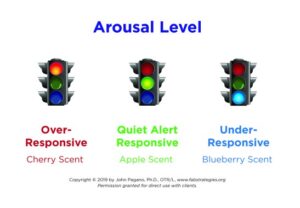After using Environmental Adaptations as the foundation for an individualized FAB (Functionally Alert Behavior) Strategies® program to help youth with complex behavioral challenges See Picture Environmental Adaptations the FAB Strategies® curriculum proceeds to describe the Sensory Modulation strategies. Sensory Modulation strategies have been found to improve behavior in children and teens with Post-Traumatic Stress (Warner et al., 2014), Autism Spectrum (Singh et al., 2011) and other mental health disorders (Brown & Gerbarg, 2013). FAB Strategies include in the Sensory Modulation section Sensory Processing, sensory occupations, Sensory-Based Interventions, Vibration, Deep pressure, light touch, scrub brushing, a variety of body based mindfulness and movement activities.
The Sensory Modulation strategies build on the environmental adaptation strategies of the photo gallery The Sensory Modulation strategy photos begin with a picture of the Arousal Level strategy. The Arousal Level strategy adapts and integrates concepts from the Alert Program, Zones of Regulation, and traffic light behavior programs.
The Arousal Level strategy uses colored traffic lights and scents to assist youth in gaining awareness of their current level of alertness as a foundation for learning to up-regulate or down-regulate their arousal to maintain a quiet alert state for learning and appropriate behavior (Corrigan et al., 2011).

The next photo gallery picture shows a child receiving back vibration.

This picture represents the use of high pressure back vibration, low level back vibration, massage, and scrub brushing to promote relaxation, body awareness, reduce self-injury, and promote appropriate behavior (Bodison & Parham, 2018; Yunus et al., 2015; Silva et al., 2013).

